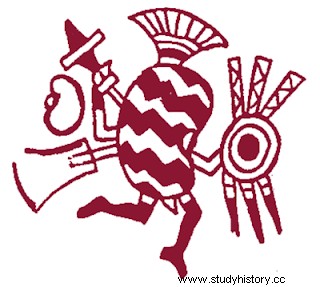 Representation of the possible pallariform script e In fact, I have found hundreds of Nasca vases, adorned with stylized lima beans, which not only appear simple and with the characteristic Mochica bichrome (red and cream), but are also combined, forming, in some cases, more complex ideograms and beautifully polychrome. There are also fabrics from this same culture, covered with lima beans, which, due to their color and design, are of great thematic variety. In the "RAFAEL LARCO HERRERA" Archeology Museum, in Chiclín, there is a fragment of cloth, in which I have counted up to 174 lima beans.
Representation of the possible pallariform script e In fact, I have found hundreds of Nasca vases, adorned with stylized lima beans, which not only appear simple and with the characteristic Mochica bichrome (red and cream), but are also combined, forming, in some cases, more complex ideograms and beautifully polychrome. There are also fabrics from this same culture, covered with lima beans, which, due to their color and design, are of great thematic variety. In the "RAFAEL LARCO HERRERA" Archeology Museum, in Chiclín, there is a fragment of cloth, in which I have counted up to 174 lima beans.In the Anthropological Museum of Magdalena del Mar, Lima, a glass of the culture of Paracas, with incised lima beans, of complicated color and design. And also among the famous cloaks of this same culture, admirable for their unparalleled textile technique, there are many with numerous representations of stylized lima beans. In some, the divinities appear with clothing adorned with lima beans and in others they are discovered with appendages containing lima beans, which, when they sprout from the mouth or chin, extend forward, as if they wanted in that way to signify the character's voice. just as the Toltecs, Aztecs and other peoples did. It is important to point out, in this regard, that within the cultures of the Mayans, the appendages that sprout from the mouths of their divinities, in effect represent the voice. The ideograms, already in their peculiar form of grams or stylized, that appear in other cultures, broaden the field of research on prehistoric writing, in which I am committed. Something else, in some of the great mantles of Paracas, the borders are covered by hundreds of lima beans of varied designs and harmonious colors, which have a significant purely ideographic. The use of cursive decoration in textile art is reflected to our times. It is well known that during colonial times, they sent from Cuzco to the Viceroy Don Francisco de Toledo, four cloths that contained, in written form, the history of the Incas who founded the Empire of Tahuantinsuyo. The notary Alvaro Ruiz de Navamuel says the following about it:"The packages of the Ingas were written and painted on the four cloths, with medals from their women and ayllos; on the borders, the history of what happened in the time of each one of the Ingas and the fable and notables that are placed on the first cloth, one that they say about Tampo Toco and the fables of Viracocha's creations that go on the border of the first cloth, by foundation and beginning of history, each thing by itself distinctly written and indicated of the heading of me, the present secretary; and of the declaration and prevention for the intelligence of the history, and the directions and winds for the demarcation of the sites of the towns, that put by Captain Pedro Sarmiento...."
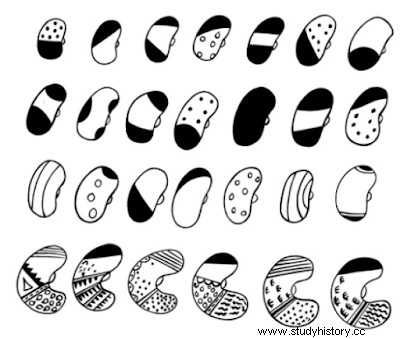 Currently, Cuzco's most valuable ponchos are adorned with letters and phrases. The saddlebags and face cloths, which the indigenous women of Eten, Monsefú and Santa Rosa - direct descendants of the Mochicas - weave exquisitely for the use of their husbands or lovers, often contain a phrase of love or a reminder. This custom, still widespread in the Peruvian territory, constitutes a wealth of informative source. It is true that the main stumbling block I had in my research, on the existence of a pre-Incan writing system, was that series of annotations that have left us the Chroniclers, all tending to deny the existence of another system other than that of the teams. But it is that the Chroniclers, when referring to writing, did not think of anything other than the alphabetic and phonetic writing of its use. Fortunately, the Revd. Father Joseph de Acosta, honorable and cultured priest of the Society of Jesus, departing from the general rule, has recorded the following in his work:"Signs that are not arranged next to mean words but things, are not called, nor are they in reality really letters, even if they are written, just as a painted image of the Sun cannot be said to be writing or letters of the Sun, but rather paint. memory, because whoever invented them did not order them to signify, but to denote that thing". And he adds later:"The other remarkable thing that is inferred is, the one that has been proposed in this chapter, namely that no nation of Indians that has been discovered in our times is one of letters or writing, but of the other two ways, which are images, or figures, and I understand this not only from the Indians of Piru, and from those of New Spain". So important concepts, allow then to reach the conviction that the ancient Peruvians used an ideographic system and not alphabetic; Well, Father Acosa wisely explains what an ideographic system is and what an alphabetic system is. ancient. This comparison gave me the opportunity to undertake a study of the two writing methods:the one recommended by me and the writing of the Maya. In this regard, Father Acosta, who has already been mentioned so many times, says:"....outside this diligence, they made up for the lack of writing and letters; part with paintings like those of Mexico, although those of Piru were very coarse and crude; part and the more with Quipos":So I took a new path, and began to study the hieroglyphs of the Maya, both those that appear on stone monuments, and those that cover the pages of the codices. And this work has not been in vain, since I have found such valuable analogies that I consider it my duty to point them out:so that important conclusions can later be reached in the study of the origin and relationships of the cultures of Pre-Inca America.
Currently, Cuzco's most valuable ponchos are adorned with letters and phrases. The saddlebags and face cloths, which the indigenous women of Eten, Monsefú and Santa Rosa - direct descendants of the Mochicas - weave exquisitely for the use of their husbands or lovers, often contain a phrase of love or a reminder. This custom, still widespread in the Peruvian territory, constitutes a wealth of informative source. It is true that the main stumbling block I had in my research, on the existence of a pre-Incan writing system, was that series of annotations that have left us the Chroniclers, all tending to deny the existence of another system other than that of the teams. But it is that the Chroniclers, when referring to writing, did not think of anything other than the alphabetic and phonetic writing of its use. Fortunately, the Revd. Father Joseph de Acosta, honorable and cultured priest of the Society of Jesus, departing from the general rule, has recorded the following in his work:"Signs that are not arranged next to mean words but things, are not called, nor are they in reality really letters, even if they are written, just as a painted image of the Sun cannot be said to be writing or letters of the Sun, but rather paint. memory, because whoever invented them did not order them to signify, but to denote that thing". And he adds later:"The other remarkable thing that is inferred is, the one that has been proposed in this chapter, namely that no nation of Indians that has been discovered in our times is one of letters or writing, but of the other two ways, which are images, or figures, and I understand this not only from the Indians of Piru, and from those of New Spain". So important concepts, allow then to reach the conviction that the ancient Peruvians used an ideographic system and not alphabetic; Well, Father Acosa wisely explains what an ideographic system is and what an alphabetic system is. ancient. This comparison gave me the opportunity to undertake a study of the two writing methods:the one recommended by me and the writing of the Maya. In this regard, Father Acosta, who has already been mentioned so many times, says:"....outside this diligence, they made up for the lack of writing and letters; part with paintings like those of Mexico, although those of Piru were very coarse and crude; part and the more with Quipos":So I took a new path, and began to study the hieroglyphs of the Maya, both those that appear on stone monuments, and those that cover the pages of the codices. And this work has not been in vain, since I have found such valuable analogies that I consider it my duty to point them out:so that important conclusions can later be reached in the study of the origin and relationships of the cultures of Pre-Inca America.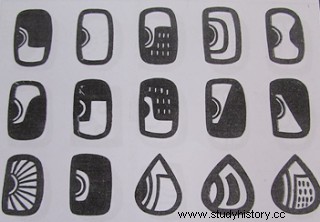 (Nasca Ideograms, color is used in these) In this article, precisely, I am going to limit myself to an analytical and concrete study of the first similarities found:
(Nasca Ideograms, color is used in these) In this article, precisely, I am going to limit myself to an analytical and concrete study of the first similarities found: THE SIGNS.- Regarding the shape, in some cases they appear oval and in others with the same ovality, but with a point at one end. There are reniform hieroglyphs and many semi-rectangular ones, with oval corners. there was only a great similarity between them, but some were even identical.
THE GERMINATIVE YOLK.- In most of the Mayan glyphs, almost always in the place where the germinative bud of the lima bean should be fixed, a circular, rectangular drawing, or circular parallel lines, or simply a thick rectangular line is observed, with what seems to be intended to represent the germinative bud. In some cases, only the outline is presented; but this detail should not be surprising, since in the idiographic lima beans of the ancient Peruvians, the germinative bud frequently disappears. The germinative bud of the lima bean is represented in the ideographic signs of the Peruvian cultures, in the same way that the Mayans did.
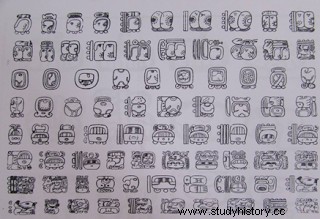 (Mayan hieroglyphics. Note the insistence on drawing circles, ellipses, semicircles, fragments of ellipses, circles and concentric ellipses, which give the impression that they wanted to represent the germinative bud of the lima bean. There are also kidney-shaped representations, similar to cereal) ORDINATION.- The Mayans arranged their glyphs in horizontal and perpendicular lines, and also, in some cases, they appear indistinctly, around mythical or symbolic characters. The men of Nasca and Paracas arranged their ideograms on the fabrics, also in horizontal and vertical lines; and within the Mochica pottery, the ideograms appear surrounding the globular vessels, in horizontal lines, or indistinctly mixed with the symbolic representations, or together with the divinities.
(Mayan hieroglyphics. Note the insistence on drawing circles, ellipses, semicircles, fragments of ellipses, circles and concentric ellipses, which give the impression that they wanted to represent the germinative bud of the lima bean. There are also kidney-shaped representations, similar to cereal) ORDINATION.- The Mayans arranged their glyphs in horizontal and perpendicular lines, and also, in some cases, they appear indistinctly, around mythical or symbolic characters. The men of Nasca and Paracas arranged their ideograms on the fabrics, also in horizontal and vertical lines; and within the Mochica pottery, the ideograms appear surrounding the globular vessels, in horizontal lines, or indistinctly mixed with the symbolic representations, or together with the divinities.HUMANIZATION.- Both the Mayans and the Mochicas anthropomorphize their signs:and humanization is verified, substituting the germinative yolk for the face of a character.
COMBINATION OF SIGNS.- Among the Mayans, some glyphs appear superimposed on each other; they also combine two signs, uniting them with symmetry, to achieve a combined sign. This same modality is frequently found among the Nasca vases. The representation of the hand as a sign is common in Mexican codices. And it is also represented in Nasca pottery.
IDEOGRAPHIC ELEMENTS.- Find many similar ideographic elements, in the Mayan signs and in the Peruvian ideograms, with points of different sizes and numbers, circles, simple and parallel straight lines, straight lines and parallel curves, semicircles, broken lines, etc. However, it is my duty to state that the Mayan signs are more complicated and denote a greater evolution.
GERMINATION IN THE SIGNS- This analogy must be considered as the most important. In the Mayan Codices, glyphs appear with the germinative bud and with the characteristic dots and lines of the bean; Something else in one of these glyphs I have been able to glimpse, that the artist even wanted to represent the wrinkles that form on the surface of the grain, when it dries abnormally. Many of the Mayan signs appear germinating. In some, the initial bud emerges vigorously; in others, the shoots are double, constituting the second stage of growth. And the culmination of the vegetative process is represented by the appearance of the first twigs with leaves. This same integral process is also offered by the Nasca ideographic signs.
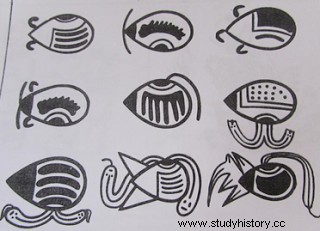 (Nasca ideograms. The lima beans, with different ideographic signs, are germinating)
(Nasca ideograms. The lima beans, with different ideographic signs, are germinating) ZOO-ANTHROPOMORPHIC CHARACTERS.- Encouraged by these suggestive analogies, I began to study the codices. Greater was my interest, when I found the Mayan divinities - alone in some cases and in others seated one in front of the other - holding in their hands Mayan signs, very similar to the lima beans; such as the Mochica divinity, also with a character in front and holding large lima beans, in the very act of deciphering. In the Troano Codex (Etudes sur le système graphique et la langue des Mayas par M. Brasseur de Bourbourg, Paris, 1869), I verified something else, which caught my attention:as always. I have maintained that the Mochicas used symbolic characters to denote the qualities of the individual through deer, birds, centipedes, dragonflies, etc., anthropomorphized, with the primary purpose of giving the idea of speed, in the performance of their messenger functions. The anthropomorphic fox symbolized the deciphered, as well as the feline and the vizcacha (Andean squirrel), both anthropomorphized. In this Codex, I have found seated zoo-anthropomorphic characters, just as they are found among the Mochicas, and I have been able to identify the fox, the feline, the rabbit and the deer, with the particularity of having all of them, at their side, the Mayan glyphs with shapes similar to the Peruvian lima beans. The tendency to anthropomorphize animals, especially those that appear with ideographic signs that are in their possession or next to them, has to worry all of us who dedicate ourselves to these studies, increasing even more the concern, when verifying that in both towns warn these zoo-anthropomorphic symbolizations.
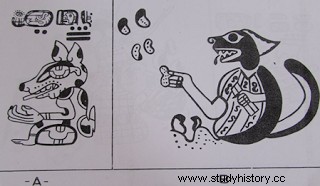 A. The Mayan Anthropomorphic Feline. B. The Mochica Anthropomorphic Feline.) (
A. The Mayan Anthropomorphic Feline. B. The Mochica Anthropomorphic Feline.) ( In other pages of the same Troano Codex, the scribes also appear:in some cases, with punches similar to those used by the Mochica scribes, holding in their hands a sign in the shape of a bean; and in others, at the precise moment of painting one of these signs. Although the Mochicas affected the lima beans, which were later transported by the chasquis, however, it is worth clarifying now that the Nasca men used a certain painting on the lima beans. In the National Museum of Lima, I found the bags containing the colors and a bean, somewhat deteriorated, with traces of having been painted.
 (A. The Mochica anthropomorphic deer. B. The Mayan anthropomorphic deer.)
(A. The Mochica anthropomorphic deer. B. The Mayan anthropomorphic deer.) 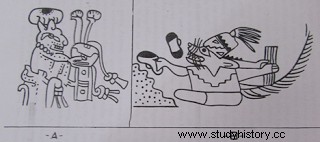 A. Maya anthropomorphic rabbit. Next to the head, there is a glyph identical to the Peruvian lima beans-ideograms. In his hands, he has a hieroglyph from which leaves sprout.
A. Maya anthropomorphic rabbit. Next to the head, there is a glyph identical to the Peruvian lima beans-ideograms. In his hands, he has a hieroglyph from which leaves sprout.B. Mochica anthropomorphic vizcacha.
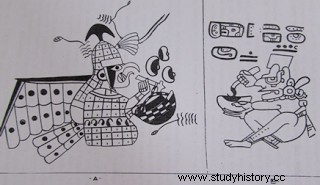 A. Type Mochica.
A. Type Mochica.B. Write Maya. Note that the sign that he has in his hand is almost identical to the ideogram in the form of a bean, which the symbolic character that the scribe represents has in front of his beak.
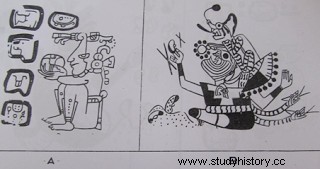 (A.- Mayan divinity, holding a hieroglyph in his hand.B.- Mochica Divinity, holding an ideogram in his hand.)
(A.- Mayan divinity, holding a hieroglyph in his hand.B.- Mochica Divinity, holding an ideogram in his hand.) 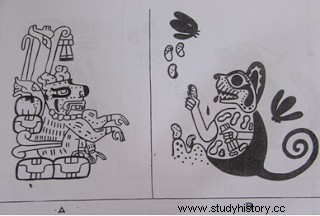
As the analysis becomes extreme, then, the problem of analogies acquires greater interest, to the point that it forces us to persevere. But I have not yet finished my study of the codices, and I do not know how many more surprises their careful analysis will bring. However, advancing a little, I have thought it convenient to give the scientists of America, perhaps a brief outline of the analogies found, to incorporate them into a methodical and serene study. Well, I am convinced that the problems that will arise and multiple questions that will arise are great. For this very reason, it is necessary to lucidly approach our American archaeological horizon, so rich and still enigmatic. Hopefully this call will have an echo, and promote Anthropological Science and that it wins in this tangled field of research in this century.
Rafael Larco Hoyle DOWNLOAD THE PDF HERE http://www.saantropologia.com.ar/wp-content/uploads/2015/01/Relaciones4/04-Hoyle.pdf
